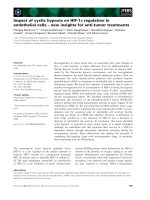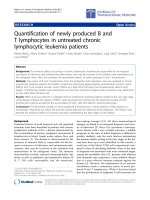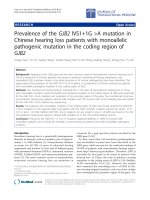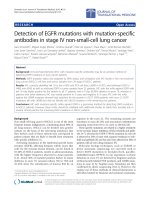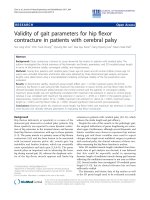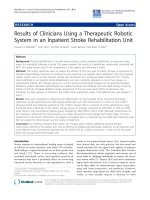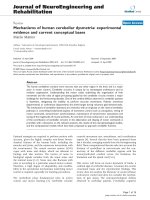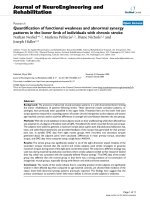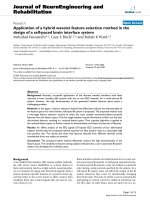Báo cáo hóa học: " VPg of murine norovirus binds translation initiation factors in infected cells" potx
Bạn đang xem bản rút gọn của tài liệu. Xem và tải ngay bản đầy đủ của tài liệu tại đây (405.3 KB, 7 trang )
BioMed Central
Page 1 of 7
(page number not for citation purposes)
Virology Journal
Open Access
Research
VPg of murine norovirus binds translation initiation factors in
infected cells
Katie F Daughenbaugh
1
, Christiane E Wobus
2
and Michele E Hardy*
1
Address:
1
Veterinary Molecular Biology, Montana State University, Bozeman, MT, USA and
2
Department of Pathology and Immunology,
Washington University School of Medicine, St Louis, MO, USA
Email: Katie F Daughenbaugh - ; Christiane E Wobus - ; Michele E Hardy* -
* Corresponding author
Abstract
Background: Norovirus genomic and subgenomic RNAs are covalently linked at the 5' nucleotide
to a 15 kD protein called VPg. VPg of two human norovirus strains binds translation initiation factor
eIF3 and other eIFs in vitro, suggesting VPg functions in initiation of protein synthesis on viral RNA.
Human norovirus strains are not cultivable, and thus experimental evidence of interactions
between VPg and eIFs in infected cells has been lacking. We used the cultivable murine norovirus
MNV-1 as a model to study interactions between VPg and eIFs in infected cells.
Results: As shown previously for human norovirus VPg, MNV-1 VPg bound eIF3, eIF4GI, eIF4E,
and S6 ribosomal protein in cell extracts by GST pull-down assay. Importantly, MNV-1 VPg co-
precipitated eIF4GI and eIF4E from infected macrophages, providing evidence that VPg interacts
with components of the translation machinery in norovirus infected cells.
Conclusion: The interactions between MNV-1 VPg and eIFs completely mimic those reported for
the human norovirus VPg, illustrating the utility of MNV-1 as a relevant molecular model to study
mechanisms of human norovirus replication.
Background
Noroviruses constitute a genus in the family Caliciviridae
and are the most frequent cause of foodborne viral gastro-
enteritis epidemics [1]. The norovirus genome is a 7.7 kb,
positive-sense, single-stranded RNA that is polyade-
nylated at the 3' end. The genome codes for three open
reading frames. ORF1 encodes the nonstructural proteins
that are synthesized as a polyprotein precursor and proc-
essed by the 3C-like viral protease. ORF2 and ORF3
encode the capsid protein VP1 and minor structural pro-
tein VP2, respectively. Both VP1 and VP2 are synthesized
from a subgenomic RNA that is 3' coterminal with the
genomic RNA. Instead of a 7-methylguanosine (m
7
G) cap
structure at the 5' end, genomic and subgenomic RNAs are
covalently linked to a viral protein called VPg, for viral
protein genome-linked. The linkage between VPg and the
5' nucleotide has been demonstrated experimentally only
for the animal caliciviruses [2,3], but by analogy, it is
assumed that VPg also is linked to norovirus genomes.
The function(s) of VPg in the norovirus replication cycle
are not known, but data that this small protein functions
in translation initiation are accumulating. Studies of ani-
mal caliciviruses showed VPg is necessary for infectivity of
native viral RNA [2], but an m
7
G cap can confer infectivity
to in vitro synthesized feline calicivirus (FCV) genomic
RNA transcripts [4]. Together, data from these studies con-
clude that the m
7
G cap functionally substitutes for VPg
when transfecting calicivirus RNA into cells. We previ-
Published: 23 May 2006
Virology Journal 2006, 3:33 doi:10.1186/1743-422X-3-33
Received: 06 March 2006
Accepted: 23 May 2006
This article is available from: />© 2006 Daughenbaugh et al; licensee BioMed Central Ltd.
This is an Open Access article distributed under the terms of the Creative Commons Attribution License ( />),
which permits unrestricted use, distribution, and reproduction in any medium, provided the original work is properly cited.
Virology Journal 2006, 3:33 />Page 2 of 7
(page number not for citation purposes)
ously reported that VPg of the Norwalk (NV) and Snow
Mountain (SMV) strains of human norovirus bound
translation initiation factor eIF3, providing the first direct
evidence that VPg may function in ribosome recruitment
to viral RNA [5]. Recently, an interaction between FCV
VPg and translation initiation factor eIF4E was reported,
and this interaction was required for translation of FCV
VPg-linked RNA in vitro [6].
Most cellular mRNAs are translated by a cap-dependent
mechanism driven by protein-protein and protein-RNA
interactions between translation initiation factors (eIFs)
and mRNA [7]. Cap-dependent translation initiates with
binding of the eIF4F complex that consists of eIF4E,
eIF4GI and eIF4A, to the m
7
G cap structure. Recruitment
of the 43S pre-initiation complex composed of eIF3, 40S
ribosomal subunits, and initiator tRNA to mRNA occurs
primarily through interactions between eIF4GI and eIF3
[8,9]. This 48S complex scans the mRNA to initiate trans-
lation at the first strong context AUG. Cap-independent
translation is mediated by extensively structured regions
of RNA called internal ribosome entry sites (IRES). These
elements are found in genomes of picornaviruses, pestivi-
ruses, and insect viruses of the Dicistroviridae family [10],
and some cellular mRNAs as well (reviewed in [11]. Initi-
ation complexes assemble internal to the 5' end of the
RNA molecule and translation initiates at, or shortly
downstream, of the IRES. The fact that norovirus RNAs
lack a m
7
G cap, are 5' nucleotide-protein linked, and have
5' untranslated regions (UTR) of only 10 nucleotides sug-
gest translation initiation on norovirus RNA mediated by
VPg proceeds in a manner distinct from cap-dependent
and IRES-dependent mechanisms.
VPg of human noroviruses binds directly to eIF3, is
present in complexes with other eIFs, and inhibits transla-
tion of mRNAs that have different eIF requirements for
functional initiation complex assembly [5]. All of these
data were obtained using purified protein and cell-free
assays. Human noroviruses do not grow in cell culture,
and therefore, connecting this eIF binding data with
events that occur in norovirus infected cells is challenging.
A significant advance in the field was the discovery of a
murine norovirus (MNV-1) that replicates in cultured
macrophages and dendritic cells [12,13]. MNV-1 is the
only norovirus that grows in culture, and is closely related
genetically to the human norovirus strains [12]. There-
fore, we used MNV-1 to address questions about the func-
tional significance of interactions between VPg and eIFs
observed with the human noroviruses. In addition, deter-
mining whether protein-protein interactions are the same
between the human and murine viruses would establish
whether MNV-1 constitutes a relevant molecular model
for the non-cultivable human strains. Our data show that
MNV-1 VPg binds eIFs in infected cells, and that interac-
tions between MNV-1 VPg and eIFs are the same as those
that occur between eIFs and human norovirus VPg. These
findings indicate that MNV-1 represents an important
molecular tool for the study of human noroviruses in tis-
sue culture.
Results
Recombinant MNV-1 VPg binds eIF3, eIF4GI, eIF4E, and S6
ribosomal protein in vitro
VPg of genogroup I NV and genogroup II SMV share 68%
amino acid sequence identity and both bind purified eIF3
and to eIF3 in cell extracts [5]. VPg sequences of MNV-1
and NV were aligned and share 54% identity (Figure 1).
The N- and C-terminal domains showed the highest level
of conservation, and flank a central variable region that
includes a glycine-rich, nine amino acid insertion in NV
VPg. Interpreted in the context of the inferred function of
MNV-1 VPg and NV VPg share significant amino acid sequence identityFigure 1
MNV-1 VPg and NV VPg share significant amino acid sequence identity. Sequences encoding MNV-1 VPg and NV
VPg were aligned with ClustalW. Asterisks indicate identical residues. Semicolons are conservative substitutions. Amino acid
numbers correspond to the position in the ORF1 polyprotein.
MNV-1 GK-KGKNKKGRGRPG VFRTRGLTDEEYDEFKKRRESRGGKYSIDDYLADRER- 921
NV GKNKGKTKKGRGRKNNYNAFSRRGLSDEEYEEYKKIREEKNGNYSIQEYLEDRQRY 1018
** *** ****** * ***:****:*:** ** : *:***::** **:*
MNV-1 EEELLERDE EEAIFGDGFGLKATRRSRKAERAKLGLVSGGDIRARKPIDWN 972
NV EEELAEVQAGGDGGIGETEMEIRHRVFYKSKSKKHQQEQRRQLGLVTGSDIRKRKPIDWT 1078
**** * : * * * ::: :: :* :****:* *** ******
MNV-1 VVGPSWADDDRQVDYGEKINFE 994
NV PPKNEWADDDREVDYNEKINFE 1100
****** *** ******
Virology Journal 2006, 3:33 />Page 3 of 7
(page number not for citation purposes)
VPg in translation, an overall amino acid sequence iden-
tity of 54%, and conservation in both N and C-terminal
domains, suggested that MNV-1 could have similar eIF
binding properties as NV VPg.
To test if MNV-1 VPg binds eIFs in a cell-free system, VPg
was expressed as a GST fusion protein in bacteria, purified
(Figure 2A), and used in pull-down assays with extracts
prepared from RAW 264.7 macrophages as previously
described [5]. Proteins in pull-down eluates were ana-
lyzed by immunoblots probed with antibodies to eIF3
(Figure 2B), phospho-eIF4GI (Figure 2C), eIF4E (Figure
2D), and S6 ribosomal protein (Figure 2E). Similar to data
obtained for NV VPg, all of these factors bound MNV-1
GST-VPg.
eIF3 is a large complex composed of 12 subunits [7]. Four
of these subunits, eIF3a, eIF3b/eIF3c doublet [14], and
eIF3d, were identified in the VPg pull-down eluates. Iden-
tification was made by the banding pattern that is
observed for eIF3 when this polyclonal antibody is used as
a probe [14]. The reasons for detecting only a few of the
subunits in the eluates are not known, but this large com-
plex may be unstable under conditions of the assay. The
anti-eIF3 serum contains antibodies to eIF4GI [14]. There-
fore, the high molecular weight protein detected in the
immunoblots probed with this serum likely represents
eIF4GI. The presence of this factor in the pull-down reac-
tions was confirmed by probing the blots with an anti-
phospho-eIF4GI antibody (Figure 2C). The lower molec-
ular weight products that reacted with the phospho-
eIF4GI antibody are interpreted to be degradation prod-
ucts of the full-length protein. Taken together, the data
from the pull-down assays and previous results show that
the interactions between NV VPg and eIFs and between
MNV-1 VPg and eIFs are the same.
VPg and eIFs co-precipitate from MNV-1 infected RAW
264.7 cells
To investigate interactions between VPg and eIFs in
infected cells, RAW 264.7 cells were infected with MNV-1
and immunoprecipitations (IP) were performed follow-
ing established protocols [13,15]. MNV-1 VPg was present
in infected but not mock infected cell lysate (Figure 3A,
lane 2, middle panel) and antibodies to VPg immunopre-
cipitated VPg (Figure 3A, lane 4, middle panel) and phos-
pho-eIF4GI (Figure 3A, lane 4, top panel). The polar
nature of VPg results in a somewhat diffuse migration in
SDS polyacrylamide gels instead of a sharp band (Daugh-
enbaugh and Hardy, unpublished observations). In the
reciprocal experiment, anti-phospho-eIF4GI antibody
precipitated phospho-eIF4GI (Figure 3A, lanes 5 and 6,
top panel) and MNV-1 VPg (Figure 3A, lane 6, middle
panel). This demonstrates MNV-1 VPg binds eIF4GI in
virus-infected cells.
Three additional observations about eIF4GI can be made
from these experiments. First, there was a reproducible
increase in the amount of phospho-eIF4GI in infected
cells compared to mock infected cells (Figure 3A lanes 1,
MNV-1 GST-VPg binds eIF3, phospho-eIF4GI, eIF4E, and S6 ribosomal protein by pull-down assayFigure 2
MNV-1 GST-VPg binds eIF3, phospho-eIF4GI, eIF4E, and S6 ribosomal protein by pull-down assay. GST and
MNV-1 GST-VPg were expressed in bacteria and purified as described in the text. A) Purified GST and GST-VPg, analyzed by
10% SDS-PAGE and stained with Coomassie blue. Proteins in the pull-down eluates were subjected to SDS-PAGE, and then
immunoblot probed with (B) anti-eIF3, (C) anti-phospho-eIF4GI, (D) anti-eIF4E, and (E) anti-S6 ribosomal protein. Blots were
developed with ECL chemiluminescent substrate. The asterisk in B indicates a protein identified as eIF4GI.
G
S
T
M
N
V
-1
G
ST
-VP
g
eIF3a
eIF3b
eIF3c
eIF3d
ABC
*
111 kD
92 kD
53 kD
111 kD
92 kD
53 kD
36 kD
29 kD
36 kD
G
S
T
M
N
V
-
1
G
S
T
-V
P
g
eIF4GI
G
S
T
M
N
V-
1
G
S
T
-VP
g
S6
36 kD
29 kD
53 kD
92 kD
111 kD
DE
29 kD
eIF4E
M
N
V-
1
G
S
T
-VP
g
G
S
T
111 kD
G
S
T
M
NV
-
1
G
ST
-
V
P
g
29 kD
36 kD
53 kD
29 kD
53 kD
92 kD
36 kD
anti-phospho-eIF4GI anti-eIF4E
anti-S6
anti-eIF3
Virology Journal 2006, 3:33 />Page 4 of 7
(page number not for citation purposes)
Phospho-eIF4GI and eIF4E co-immunoprecipitate with VPg from MNV-1 infected RAW 264.7 cellsFigure 3
Phospho-eIF4GI and eIF4E co-immunoprecipitate with VPg from MNV-1 infected RAW 264.7 cells. A) Mock
infected or infected cell lysates were subjected to immunoprecipitation with anti-MNV-1 VPg (lanes 3 and 4) or anti-phospho-
eIF4GI (lanes 5 and 6). Immunoblots were probed with the relevant antibody indicated to the left of the panels. Lanes 1 and 2
are control lysates that did not receive antibody. B) Mock infected or infected cell lysates probed with anti-eIF4GI.
A
phospho-eIF4GI
MNV-1 VPg
M
o
c
k
I
n
f
ec
t
e
d
cell lysate (no IP)
12
107kD
81kD
48kD
20kD
I
n
f
ec
t
e
d
M
o
c
k
IP anti-VPg
34
107kD
81kD
48kD
20kD
IP anti-phospho-eIF4GI
I
n
f
ec
t
e
d
M
o
c
k
56
107kD
81kD
48kD
20kD
25kD 25kD
eIF4E
eIF4GI
cell lysate (no IP)
M
o
c
k
I
n
f
ec
t
e
d
12
107kD
81kD
48kD
B
Virology Journal 2006, 3:33 />Page 5 of 7
(page number not for citation purposes)
2, 5 and 6, top panels). However, the levels of total
eIF4GI, irrespective of its phosphorylation status, were
similar in mock and infected cell lysates (Figure 3B) sug-
gesting that differences in the amount of phospho-eIF4GI
cannot be attributed to increased expression of eIF4GI. It
has been reported that the amount of eIF4GI phosphor-
ylated at serines 1108, 1148 and 1192 increases in
response to serum stimulation, and phosphorylation at
these sites is modulated by the N terminal third of the pro-
tein [16]. Potential mechanisms were proposed, including
de-repression of eIF4GI by direct phosphorylation of the
N terminus, or alternatively, interactions with an eIF4GI
binding partner to expose the C terminal domain to
kinase activity [16]. It is conceivable that MNV-1 infection
could result in activation of kinases that modulate the
activity of eIF4GI. An alternative and not mutually exclu-
sive possibility is that direct interactions between eIF4GI
and VPg alter the conformation of eIF4GI to a form where
the C terminal serine residues are phosphorylated.
A second observation is that several eIF4GI degradation
products were found in cell lysate (Figure 3A, lanes 1 and
2, top panel), or when protein was immunoprecipitated
with anti-phospho-eIF4GI antibody (Figure 3A, lanes 5
and 6, top panel). In contrast, anti-VPg antibody exclu-
sively precipitated full-length eIF4GI. If the interaction
between VPg and eIF4GI is direct, these data suggest a
binding site for VPg could reside in the N-terminal two-
thirds of eIF4GI, since the phospho-eIF4GI antibody rec-
ognizes the C terminal third of the protein. If the interac-
tion between VPg and eIF4GI is indirect, full length
eIF4GI could have been brought down by a potential
direct interaction between VPg and eIF4E because an
eIF4E binding site resides in the N terminus of eIF4GI
[17].
Finally, the presence of identical degradation products in
both mock and infected cell lysates suggests that, in con-
trast to FCV infections [18], eIF4GI is not detectably
cleaved during MNV-1 infection. Although we have not
performed extensive analysis of eIF4GI cleavage, these
data are consistent with reports that recombinant norovi-
rus 3C protease (MD-145 strain) does not cleave eIF4GI in
vitro [19]. This degradation pattern was not observed
when mock and infected cell lysates were probed with
antibody to total eIF4GI (Figure 3B). The reason for this
discrepancy is not entirely clear, but we have observed
some variability in the stability of eIF4GI in RAW 264.7
cells lysates. The degradation products also could be C-ter-
minal fragments of the protein not recognized by the
eIF4GI antibody made to an N-terminal peptide that was
used to detect the full-length protein.
Goodfellow and co-workers recently reported that FCV
VPg co-precipitates eIF4E from infected cells, and that this
interaction is necessary for translation of FCV VPg-linked
RNA in vitro [6]. To determine if MNV-1 VPg was associ-
ated with eIF4E in infected cells, we immunoprecipitated
VPg from infected cell lysates and probed samples by
immunoblot for eIF4E. eIF4E was found in similar quan-
tities in mock and infected cell lysates in the absence of
antibody (Figure 3A, lanes 1 and 2, bottom panel), and
co-precipitated with VPg from infected cells (Figure 3A,
lanes 3 and 4, bottom panel). These data indicate that
MNV-1 VPg and eIF4E interact in infected cells. Further
studies are necessary to determine if this interaction with
MNV-1 VPg is direct, or if eIF4E is detected as a result of
interactions with other components of eIF4F.
Discussion
We and others put forth the idea that VPg functions in
translation initiation on VPg-linked RNA through interac-
tions with eIFs [3,5,6,20]. The data presented here provide
experimental evidence of interactions between VPg and
eIFs in norovirus infected cells, and strengthen the asser-
tion that the interactions previously defined for NV VPg
by cell-free assays are relevant and functional.
eIF3, eIF4GI, and eIF4E were detected in GST pull-down
eluates of both NV VPg [5] and MNV-1 VPg (this study),
and eIF4GI and eIF4E were found in co-immunoprecipi-
tates with VPg from MNV-1 infected cells. While these
assays do not prove a direct interaction between VPg and
these translation initiation factors, they strongly suggest
VPg interacts with one or more components of the eIF4F
complex. These observations lend support to previous
suggestions that VPg is a protein cap analogue with respect
to binding interactions with eIF4F. We further suggest that
the role of VPg in ribosome recruitment is more complex
than providing a target for eIF4F binding. VPg is a 15 kD
protein covalently linked to the 5' end of an RNA that has
a 10 nucleotide 5' UTR. If VPg functions simply as a pro-
tein cap, then by analogy to capped mRNA, translation
initiation at nucleotide 11 would be inefficient [21].
Moreover, direct interactions between VPg and eIF3 [5]
point to the potential involvement of VPg in 43S pre-ini-
tiation complex recruitment. Sequence conservation
between VPg and initiation factor eIF1A, a factor impor-
tant in AUG codon recognition and ternary complex
recruitment [22], has been noted for NV VPg [23], and a
similar degree of conservation exists between MNV-1 VPg
and eIF1A (data not shown). We have suggested a model
of translation initiation on NV VPg-linked RNA that we
now extend to MNV-1, whereby a direct interaction
between VPg and eIF3, and likely components of eIF4F,
positions the ribosome at the initiator AUG without
ribosome scanning. This model implies numerous con-
certed interactions between norovirus VPg and eIFs,
including the 40S ribosome, additional to the interactions
reported so far.
Virology Journal 2006, 3:33 />Page 6 of 7
(page number not for citation purposes)
Studies with animal calicivirus strains in the Vesivirus
genus of the family, particularly FCV, have contributed a
large body of data on mechanisms of calicivirus replica-
tion [19,24-26]. These data provide a good foundation on
which to build models of norovirus replication by anal-
ogy. However, these analogies have limitations, largely
due to the genetic divergence between animal caliciviruses
and noroviruses. For example, FCV VPg and NV VPg share
only 18% amino acid identity, and thus far we and others
[6] have been unable to detect interactions between FCV
VPg and eIF3 or eIF4GI in GST pull-down assays. We have
not performed extensive binding studies with FCV VPg to
determine what interactions may occur that are different
from those observed with the norovirus VPg, but it is
probable that specific interactions and mechanistic details
differ between the animal caliciviruses and noroviruses.
These observations exemplify the importance of MNV-1
as a molecular model for human noroviruses, as interac-
tions between MNV-1 VPg and eIFs precisely mimic those
reported for NV VPg.
Methods
RAW 264.7 Cells
RAW 264.7 cells (ATCC TIB-71) were maintained in
DMEM containing 10% FBS (Atlanta Biologicals), 10 mM
Hepes, 4 mM L-glutamine, 4.5 g/L glucose, and 1.5 g/L
sodium bicarbonate.
Construction of GST-MNV-1 VPg and GST pull-down
assays
MNV-1 VPg was amplified from pSPORT-T7-MNV-1 (gift
from H. Virgin, Washington University School of Medi-
cine) using the primers MNV-VPg/BamHI(+) 5'-cgcggatc-
cggaaagaagggcaagaac-3' and MNV-VPg/XhoI(-) 5'-
ccgctcgag
ctcaaagttgatcttctcg-3'. Restriction sites for clon-
ing are underlined. Reactions were assembled using the
KOD kit (Novagen) according to instructions provided by
the manufacturer. Amplification conditions consisted of
25 cycles of 98°C for 15 seconds, 58°C for 3 seconds, and
72°C for 5 seconds. The amplification product was cloned
into pGEX-4-T1 (GE Amersham Biosciences) using
BamHI and XhoI restriction enzymes. Expression and
purification of GST-MNV-VPg, as well as pull-down assays
using RAW 264.7 cell lysates, were performed as described
previously [5].
Immunoprecipitations
RAW 264.7 cells were grown to 90% confluence in 10 cm
dishes, and infected with MNV-1 for 17 hours at a multi-
plicity of infection of 1.5 pfu/cell. Cells were harvested in
1 mL of cold medium and pelleted for 5 minutes at 3000
× g at 4°C. Pellets were washed twice in cold phosphate-
buffered saline, and lysed by incubation on ice for 30
minutes in 500 µL IP buffer containing 20 mM Tris-HCl
pH 7.5, 50 mM NaCl, 0.1% NP-40, 10 mM β-glycerophos-
phate, 5 mM NaF, 2.5% glycerol, and one mini protease
inhibitor cocktail tablet (Roche Biochemicals). Lysates
were clarified by centrifugation for 5 minutes at 10,000 ×
g at 4°C. Ten µl (2%) of each sample was retained as con-
trols and not subjected to immunoprecipitation. The
remaining lysate was incubated with the indicated anti-
body and rotated gently for two hours at 4°C. Anti-phos-
pho-eIF4GI (Cell Signaling Technologies) was used at a
dilution of 1:100 and anti-MNV-1 VPg (provided by Kim
Green, NIAID) was used at a dilution of 1:1000. Thirty µl
of Gamma Bind Plus Sepharose beads (GE Amersham
Biosciences) prepared in IP buffer were added, and com-
plexes were rotated for one hour at 4°C. Beads were col-
lected by centrifugation for 2 minutes at 500 × g at 4°C,
and then washed four times with wash buffer containing
20 mM Tris-HCl pH 7.5, 50 mM NaCl, and 0.1% NP-40.
Complexes were eluted from the beads by incubation on
ice for 10 minutes in 25 µl elution buffer (0.75% wt/vol
glycine in water, pH 2.2). The beads were collected for 2
minutes at 500 × g at 4°C. Supernatants were transferred
to fresh tubes containing 0.9 µl 2 M Tris base.
Western immunoblots
Immunoprecipitation and pull-down samples were sub-
jected to SDS-PAGE and transferred to nitrocellulose,
blocked in 10% nonfat dry milk and incubated with the
indicated antibody overnight at room temperature. Anti-
bodies used were anti-phospho-eIF4GI at 1:1000, anti-S6
ribosomal protein and anti-eIF4E (both from Cell Signal-
ing Technologies) at 1:1000, anti-eIF3 (kindly provided
by John Hershey, UC Davis) at 1:2000, anti-eIF4GI (N-20,
Santa Cruz Biotechnology) at 1:1000, and anti-MNV-1
VPg at 1:2000. Appropriate horseradish peroxidase-conju-
gated secondary antibodies were used at dilutions of
1:3000. Blots were developed with ECL chemilumines-
cent substrate (GE Amersham Biosciences) and exposed
to film for similar lengths of time.
Competing interests
The author(s) declare that they have no competing inter-
ests.
Acknowledgements
We thank Herbert W Virgin (Washington University in St Louis) for gen-
erously providing reagents and advice on culture and manipulation of MNV-
1. We thank Kim Green (NIAID) for antiserum to MNV-1 VPg. This work
was supported by PHS grant AI-43450 to MEH, PHS grant P20 RR020185,
and by the Montana Agricultural Experiment Station. KFD was partially sup-
ported by the Kopriva Fellowship and USDA National Needs Program.
CEW was supported by NIH Grant U54 A1057160 to the Midwest
Regional Center of Excellence for Biodefense and Emerging Infectious Dis-
ease Research.
References
1. Green KY: Human caliciviruses. In Fields Virology Edited by: Knipe
DM, Howley PM. Lippincott Williams & Wilkins, Philadelphia, PA;
2001:841-874.
Publish with BioMed Central and every
scientist can read your work free of charge
"BioMed Central will be the most significant development for
disseminating the results of biomedical research in our lifetime."
Sir Paul Nurse, Cancer Research UK
Your research papers will be:
available free of charge to the entire biomedical community
peer reviewed and published immediately upon acceptance
cited in PubMed and archived on PubMed Central
yours — you keep the copyright
Submit your manuscript here:
/>BioMedcentral
Virology Journal 2006, 3:33 />Page 7 of 7
(page number not for citation purposes)
2. Burroughs JN, Brown F: Presence of a covalently linked protein
on calicivirus RNA. J Gen Virol 1978, 41:443-446.
3. Herbert TP, Brierley I, Brown TD: Identification of a protein
linked to the genomic and subgenomic mRNAs of feline cal-
icivirus and its role in translation. J Gen Virol 1997, 78(Pt
5):1033-1040.
4. Sosnovtsev S, Green KY: RNA transcripts derived from a
cloned full-length copy of the feline calicivirus genome do
not require VpG for infectivity. Virology 1995, 210:383-390.
5. Daughenbaugh K, Fraser CSHJW, Hardy ME: The genome linked
protein VPg of the Norwalk virus binds eIF3, suggesting its
role in translation initiation complex recruitment. EMBO J
2003, 22:2852-2859.
6. Goodfellow I, Chaudhry Y, Gioldasi I, Gerondopoulos A, Natoni A,
Labrie L, Laliberte JF, Roberts L: Calicivirus translation initiation
requires an interaction between VPg and eIF 4 E. EMBO Rep
2005, 6:968-972.
7. Hershey JWB, Merrick WC: The pathway and mechanism of ini-
tiation of protein synthesis. Translational Control of Gene
Expression. Cold Sring Harbor Laboratory Press, Cold Spring Har-
bor; 2000:33-88.
8. Hentze MW: eIF4G: a multipurpose ribosome adapter? Science
1997, 275:500-501.
9. Gingras AC, Raught B, Sonenberg N: eIF4 initiation factors: effec-
tors of mRNA recruitment to ribosomes and regulators of
translation. Annu Rev Biochem 1999, 68:913-963.
10. Sarnow P, Cevallos RC, Jan E: Takeover of host ribosomes by
divergent IRES elements. Biochem Soc Trans 2005, 33:1479-1482.
11. Hellen CU, Sarnow P: Internal ribosome entry sites in eukary-
otic mRNA molecules. Genes Dev 2001, 15:1593-1612.
12. Karst SM, Wobus CE, Lay M, Davidson J, Virgin HW: STAT1-
dependent innate immunity to a Norwalk-like virus. Science
2003, 299:1575-1578.
13. Wobus CE, Karst SM, Thackray LB, Chang KO, Sosnovtsev SV, Belliot
G, Krug A, Mackenzie JM, Green KY, Virgin HW: Replication of
Norovirus in cell culture reveals a tropism for dendritic cells
and macrophages. PLoS Biol 2004, 2:e432.
14. Meyer LJ, Milburn SC, Hershey JW: Immunochemical character-
ization of mammalian protein synthesis initiation factors.
Biochemistry 1982, 21:4206-4212.
15. Fontaine-Rodriguez EC, Taylor TJ, Olesky M, Knipe DM: Proteom-
ics of herpes simplex virus infected cell protein 27: associa-
tion with translation initiation factors. Virology 2004,
330:487-492.
16. Raught B, Gingras AC, Gygi SP, Imataka H, Morino S, Gradi A, Aeber-
sold R, Sonenberg N: Serum-stimulated, rapamycin-sensitive
phosphorylation sites in the eukaryotic translation initiation
factor 4GI. EMBO J 2000, 19:434-444.
17. Mader S, Lee H, Pause A, Sonenberg N: The translation initiation
factor eIF-4E binds to a common motif shared by the trans-
lation factor eIF-4 gamma and the translational repressors
4E-binding proteins. Mol Cell Biol 1995, 15:4990-4997.
18. Willcocks MM, Carter MJ, Roberts LO: Cleavage of eukaryotic
initiation factor eIF4G and inhibition of host-cell protein syn-
thesis during feline calicivirus infection. J Gen Virol 2004,
85:1125-1130.
19. Kuyumcu-Martinez M, Belliot G, Sosnovtsev SV, Chang KO, Green
KY, Lloyd RE: Calicivirus 3C-like proteinase inhibits cellular
translation by cleavage of poly(A)-binding protein. J Virol
2004, 78:8172-8182.
20. Dunham DM, Jiang X, Berke T, Smith AW, Matson DO: Genomic
mapping of a calicivirus VPg. Arch Virol 1998, 143:2421-2430.
21. Kozak M: A short leader sequence impairs the fidelity of initi-
ation by eukaryotic ribosomes. Gene Expr 1991, 1:111-115.
22. Pestova TV, Kolupaeva VG: The roles of individual eukaryotic
translation initiation factors in ribosomal scanning and initi-
ation codon selection. Genes Dev 2002, 16:2906-2922.
23. Sosnovtsev SV, Green KY: Identification and Genomic Mapping
of the ORF3 and VPg Proteins in Feline Calicivirus Virions.
Virology 2000, 277:193-203.
24. Green KY, Mory A, Fogg MH, Weisberg A, Belliot G, Wagner M,
Mitra T, Ehrenfeld E, Cameron CE, Sosnovtsev SV: Isolation of
enzymatically active replication complexes from feline cali-
civirus-infected cells. J Virol 2002, 76:8582-8595.
25. Sosnovtsev SV, Garfield M, Green KY: Processing map and essen-
tial cleavage sites of the nonstructural polyprotein encoded
by ORF1 of the feline calicivirus genome. 2002.
26. Sosnovtsev SV, Belliot G, Chang KO, Onwudiwe O, Green KY:
Feline calicivirus VP2 is essential for the production of infec-
tious virions. J Virol 2005, 79:4012-4024.
